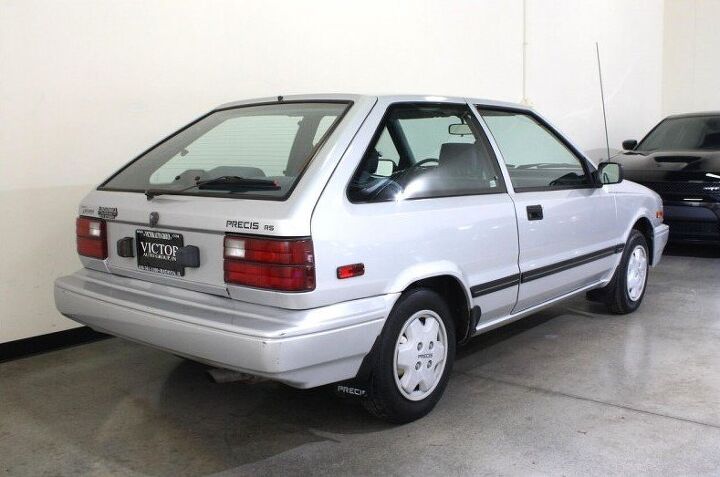Rare Rides: The 1989 Mitsubishi Precis - Discount Badge Games

Don’t let the title fool you — what we’ve got here is not a Mitsubishi at all, but rather a Hyundai. The late Eighties were confusing times at Mitsubishi, and deals with other OEMs were made left and right.
Today’s Precis is an Excel by any other name.
Hyundai followed up the successful rear-drive Pony with the more economical and contemporary Excel. What the up-and-coming Korean company really needed was a budget-priced hatchback it could sell to all of North America. If you recall, the rather agricultural Pony was unable to pass U.S. emissions standards, so it was confined to the smoggy and carefree industrial nation north of the border. The success of the Excel was incredibly important for Hyundai.
For the boxy styling, Hyundai turned to friend Giorgietto Giugiaro at Italdesign. Designer of the Pony, Giugiaro turned in similar homework for the Excel. Shapes included the short three-door hatchback seen here, as well as a four-door sedan and five-door hatch.
All models were front-drive, as dictated by economy car trends — a first for Hyundai. The company knew their potential American customer and offered manual and automatic transmissions from the get-go. All first-generation models sourced power from a 68-horsepower 1.5-liter engine.
Introducing the Hyundai marque to the United States in 1985, the first-ever Hyundai Excel sold on value. Priced at $4,995, it smashed import sale records immediately. Voted a Best Product by Fortune, Hyundai sold 168,882 Excels in America in its first year.
Mitsubishi wanted a piece of the pie.
Striking a deal with Hyundai, the Excel first appeared as the badge-engineered Precis at Mitsubishi dealers in 1987. Available only in hatchback format with three or five doors, the Precis was also Mitsubishi’s value-priced car. It was their Ace of Base, and undersold even the cheapest Mirage model.
The Excel was updated for 1990 with decently refreshed visuals and more modern technology underneath. The Precis made the switch, too, but became strictly a three-door affair. It continued drawing budget customers to Mitsubishi dealerships through 1994. The Excel lived longer than planned, but was eventually replaced by the Accent.
Today’s ’89 Precis is the upmarket RS, which surely means Rally Sport. With a five-speed manual, no rev counter, and 83,000 miles, it asks $2,250 in Illinois.
[Images: seller]

Interested in lots of cars and their various historical contexts. Started writing articles for TTAC in late 2016, when my first posts were QOTDs. From there I started a few new series like Rare Rides, Buy/Drive/Burn, Abandoned History, and most recently Rare Rides Icons. Operating from a home base in Cincinnati, Ohio, a relative auto journalist dead zone. Many of my articles are prompted by something I'll see on social media that sparks my interest and causes me to research. Finding articles and information from the early days of the internet and beyond that covers the little details lost to time: trim packages, color and wheel choices, interior fabrics. Beyond those, I'm fascinated by automotive industry experiments, both failures and successes. Lately I've taken an interest in AI, and generating "what if" type images for car models long dead. Reincarnating a modern Toyota Paseo, Lincoln Mark IX, or Isuzu Trooper through a text prompt is fun. Fun to post them on Twitter too, and watch people overreact. To that end, the social media I use most is Twitter, @CoreyLewis86. I also contribute pieces for Forbes Wheels and Forbes Home.
More by Corey Lewis
Latest Car Reviews
Read moreLatest Product Reviews
Read moreRecent Comments
- Kjhkjlhkjhkljh kljhjkhjklhkjh so what?? .. 7.5 billion is not even in the same hemisphere as the utterly stupid waste of money on semiconductor fabs to the tune of more than 100 billion for FABS that CANNOT COMPETE in a global economy and CANNOT MAKE THE US Independent from China or RUSSIA. we REQUIRE China for cpu grade silicon and RUSSIA/Ukraine for manufacturing NEON gas for cpus and gpus and other silicon based processors for cars, tvs, phones, cable boxes ETC... so even if we spend trillion $ .. we STILL have to ask china permission to buy the cpu grade silicon needed and then buy neon gas to process the wafers.. but we keep tossing intel/Taiwan tens of billions at a time like a bunch of idiots.Google > "mining-and-refining-pure-silicon-and-the-incredible-effort-it-takes-to-get-there" Google > "silicon production by country statista" Google > "low-on-gas-ukraine-invasion-chokes-supply-of-neon-needed-for-chipmaking"
- ToolGuy Clearly many of you have not been listening to the podcast.
- 1995 SC This seems a bit tonedeaf.
- 1995 SC Well I guess that will be the final nail in the Mini EV's coffin here. It was already not especially competitive, had no range and was way overpriced for what you get, but I like to get stuff like that used and well depreciated on occcasion though I likely would have passed anyway due to the Chinese manufacture.
- MKizzy If China-branded vehicles arrive on these shores filling the gaping hole of sizes, body styles, and price points largely abandoned by established automakers, they will immediately find an interested customer base among those low/middle income consumers whose parents were (un)happily puttering around in old Hyundai Excels and Yugo GVs. Personally, I do think BYD or another of their major automakers will eventually circumvent the tariffs by building in Mexico and sending vehicles north.







































Comments
Join the conversation
Hyundai and Kia selling these heaps in America to people with poor credit, only to have a car that didn't outlast the inflated high interest rate payments is one of the many reasons I will never buy Hyundai or Kia cars.
How do anything of these even exist today? Especially in IL, which is hell for cars...